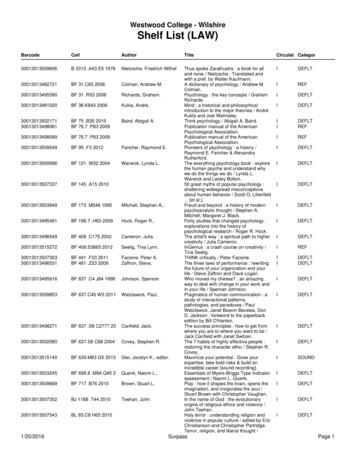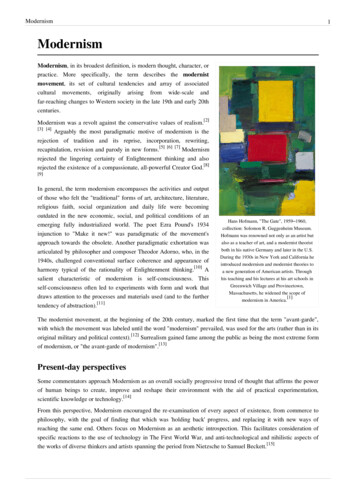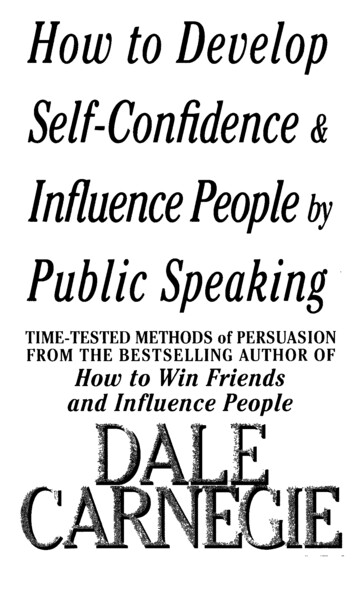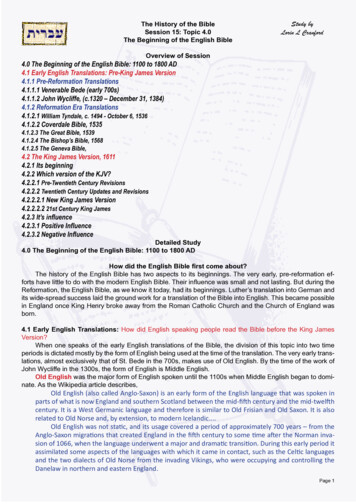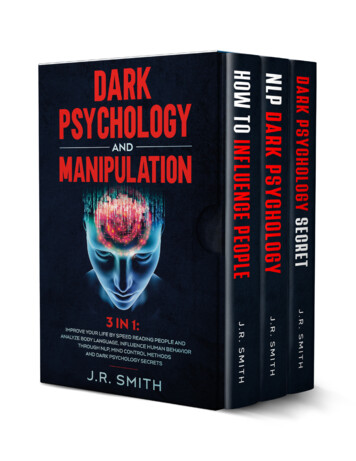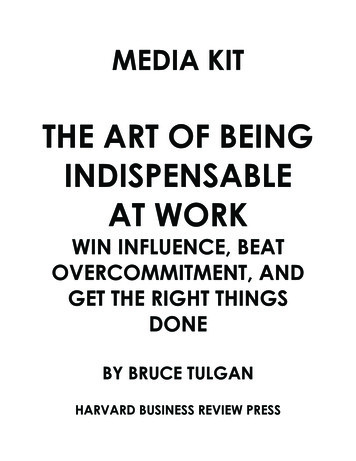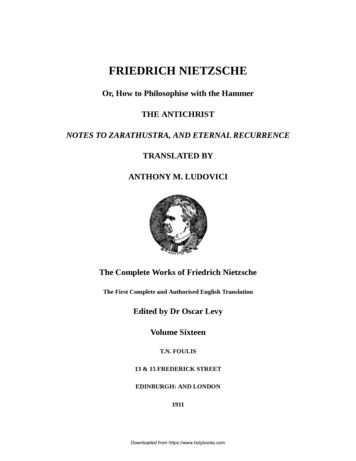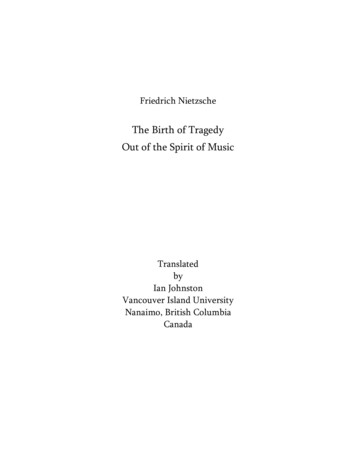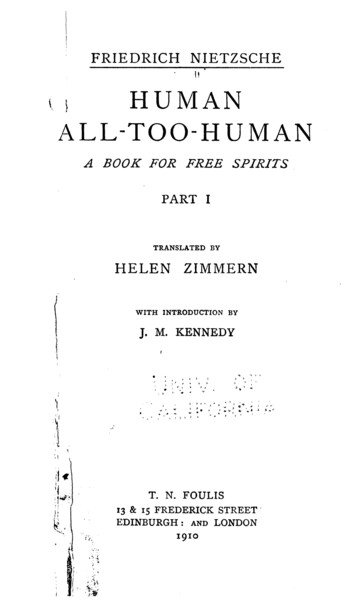
Transcription
NIETZSCHE’S INFLUENCE ON MODERNIST BILDUNGSROMAN:THE IMMORALIST, A PORTRAIT OF THE ARTIST AS A YOUNG MAN,AND DEMIANA THESIS SUBMITTED TOTHE GRADUATE SCHOOL OF SOCIAL SCIENCESOFMIDDLE EAST TECHNICAL UNIVERSITYBYHARİKA BAŞPINARIN PARTIAL FULFILLMENT OF THE REQUIREMENTSFORTHE DEGREE OF MASTER OF ARTSINTHE DEPARTMENT OF ENGLISH LITERATURESEPTEMBER 2014
Approval of the Graduate School of Social SciencesProf. Dr. Meliha AltunışıkDirectorI certify that this thesis satisfies all the requirements as a thesis for the degree ofMaster of Arts.Assoc. Prof. Dr. Nurten BirlikHead of DepartmentThis is to certify that we have read this thesis and that in our opinion it is fullyadequate, in scope and quality, as a thesis for the degree of Master of Arts.Assist. Prof. Dr. Dürrin Alpakın Martinez CaroSupervisorExamining Committee MembersAssist. Prof. Dr. Margaret J.M. Sönmez(METU, ELIT)Assist. Prof. Dr. Dürrin Alpakın Martinez Caro (METU, ELIT)Assist. Prof. Dr. Kuğu Tekin(Atılım University, IDE)
I hereby declare that all information in this document has been obtained andpresented in accordance with academic rules and ethical conduct. I also declarethat, as required by these rules and conduct, I have fully cited and referenced allmaterial and results that are not original to this work.Name, Last Name: Harika BaşpınarSignatureiii:
ABSTRACTNIETZSCHE’S INFLUENCE ON MODERNIST BILDUNGSROMAN:THE IMMORALIST, A PORTRAIT OF THE ARTIST AS A YOUNG MAN,AND DEMIANBaşpınar, HarikaM.A., Department of English LiteratureSupervisor: Assist. Prof. Dr. Dürrin Alpakın Martinez CaroSeptember 2014, 113 pagesThis thesis carries out a comparative analysis of three modernist bildungsromanswritten by André Gide, James Joyce, and Hermann Hesse in the light of Nietzscheanphilosophy. The Immoralist (1902), A Portrait of the Artist as a Young Man (1916),and Demian (1919) are all coming of age novels reflecting the zeitgeist of modernEurope at the beginning of the 20th century. It is argued that their protagonists aretypical modernist characters who show a rebellious characteristic and strive forfreedom and authenticity. Pointing out the importance of Nietzsche in the modernistcontext, this thesis tries to show his influence on Gide, Joyce, and Hesse by revealingthe Nietzschean elements found in these novels. The protagonists Michel, StephenDedalus, and Emil Sinclair are discussed as Nietzschean characters in that they detachthemselves from the herd and its values and become the creators of their own values.It is also disclosed that Gide, Joyce, and Hesse interpret this philosophy in differentways. Gide, in The Immoralist, intends to make a warning that if misread, Nietzscheanideas may result in an aimless individualism and destruction. Joyce, on the other hand,uses this philosophy quite positively. Although Stephen’s future is not known to thereader, it is shown that in following the Nietzschean path he gains the potential toiv
become a successful artist. Finally, Hesse employs Nietzschean philosophy in hisnovel so as to make his character one of the few who can transform the world througha Nietzschean transvaluation of values.Keywords: Modernist Bildungsroman, transvaluation, contempt for the herd, freespiritsv
ÖZNIETZSCHE’NİN MODERNİST OLUŞUM ROMANI (BILDUNGSROMAN)ÜZERİNDEKİ ETKİSİ: THE IMMORALIST, A PORTRAIT OF THE ARTIST AS AYOUNG MAN, VE DEMIANBaşpınar, HarikaYüksek Lisans, İngiliz Edebiyatı BölümüTez Yöneticisi: Yrd. Doç. Dr. Dürrin Alpakın Martinez CaroEylül 2014, 113 sayfaBu tez, André Gide, James Joyce ve Hermann Hesse tarafından yazılan üç r. The Immoralist (1902), A Portrait of the Artist as a Young Man (1916)ve Demian (1919) 20. yüzyılın başında modern Avrupa’nın genel ruhunu yansıtanoluşum romanlarıdır. Başkarakterlerinin başkaldırıcı özellik gösteren ve özgürlük veözgünlük için çabalayan tipik birer modernist karakter oldukları iddia edilmektedir.Nietzsche’nin modernist bağlamda önemini vurgulayan bu tez, bu üç romandakiNietzschevari unsurları ortaya çıkararak, onun Gide, Joyce ve Hesse üzerindekietkisini göstermeye çalışmaktadır. Ana karakterler Michel, Stephen Dedalus ve EmilSinclair, kendilerini sürüden ve onun değerlerinden koparmaları ve kendi değerlerininyaratıcıları olmaları açısından Nietzschevari karakterler olarak tartışılmaktadır. Buçalışmada ayrıca, Gide, Joyce ve Hessenin bu felsefeyi farklı şekillerdedeğerlendirdikleri de gösterilmektedir. The Immoralist’te Gide yanlış yorumlanırsaNietzsche’nin fikirlerinin amaçsız bir bireysellik ve yıkımla sonuçlanabileceğikonusunda bir uyarı yapmayı amaçlamaktadır. Joyce, diğer yandan, bu felsefeyioldukça pozitif bir açıdan değerlendirmektedir. Okuyucuya Stephen’ın geleceği açıkçavi
belirtilmemesine rağmen, karakterin Nietzsche’nin yolundan giderek başarılı birsanatçı olma potansiyeli kazandığı gösterilmektedir. Son olarak, Hesse, Nietzschefelsefesini karakterini değerlerin yeniden değerlendirilmesi yoluyla dünyayıdeğiştirebilecek az kişiden birine dönüştürmek amacıyla kullanmaktadır.Anahtar kelimeler: Modernist Bildungsroman, değerlerin yeniden değerlendirilmesi,sürüyü hor görme, özgür ruhvii
To My Family and Eminviii
ACKNOWLEDGEMENTSI am deeply grateful to my thesis supervisor Assist. Prof. Dr. Dürrin AlpakınMartinez Caro for her endless support and trust in my work. It is her encouragement,valuable advices, and supportive attitude that made it possible for me to write thisthesis.I would like to offer my special thanks to Assist. Prof. Dr. Margaret J. M.Sönmez, and Assist. Prof. Dr. Kuğu Tekin. I have greatly benefited from their guidanceand valuable suggestions.I also want to express my gratitude to Prof. Dr. Ayten Coşkunoğlu Bear. It isin her courses that I became familiar with the works of Joyce, Hesse, and Gide.I also thank The Scientific and Technological Research Council of Turkey(TÜBİTAK) for the financial support I received during my M.A. studies.I am particularly grateful to my family. I am indebted to my parents MülkiyeNurettin Başpınar for their love and care, and to my sister Aynur Başpınar for her loveand support. It is a relief to know that they are always there for me.I owe my deepest gratitude to Emin Zerman. Without his limitlessencouragement and help, this thesis would not have become what it is now. I thankhim for his belief in me, for making my life richer, and for his love.ix
TABLE OF CONTENTSABSTRACT. ivÖZ. viDEDICATION. viiiACKNOWLEDGEMENTS. ixTABLE OF CONTENTS. xLIST OF ABBREVIATIONS. xiiCHAPTER1. INTRODUCTION. 11.1. 19th Century Thought and Nietzsche. 11.2. Modernism and the Bildungsroman Tradition. 92. NIETZSCHEAN PHILOSOPHY. 172.1. Will to Power. 172.2. Apollonian and Dionysian Forces. 202.3. Master and Slave Moralities. 222.4. Nietzsche’s Free Spirits. 243. THE IMMORALIST. 273.1. André Gide and Nietzsche. 273.2. Michel as a Nietzschean Character. 283.2.1. Michel’s Immaturity. 283.2.2. Awakening Senses and the Will to Live. 303.2.3. Repudiation of Prevailing Norms. 323.2.4. The Triumph of the Dionysian over the Apollonian. 353.2.5. Contempt for the Herd. 363.2.6. Losing the Balance between Sensuality and Logic. 413.2.7. The “Imperfect Nietzschean”. 464. A PORTRAIT OF THE ARTIST AS A YOUNG MAN. 494.1. James Joyce and Nietzsche. 49x
4.2. Stephen Dedalus as a Nietzschean Character. 514.2.1. Guilt and Punishment. 514.2.2. Revolt against the Common Norms. 544.2.3. Religion as a Life-Denying Institution. 574.2.4. The Artist as a Free Spirit. 604.2.5. A Voluntary Exile from the Fatherland. 635. DEMIAN. 715.1. Hermann Hesse and Nietzsche. 715.2. Emil Sinclair as a Nietzschean Character. 725.2.1. Two Realms: Light and Darkness. 725.2.2. Transvaluation of Values. 745.2.3. A New Spirituality Beyond Good and Evil. 795.2.4. Those with the Mark of Cain. 846. CONCLUSION. 89REFERENCES. 95APPENDICESAppendix A: Turkish Summary.103Appendix B: Tez Fotokopisi İzin Formu. 113xi
LIST OF ABBREVIATIONSBGEBeyond Good and EvilBTThe Birth of TragedyGMOn the Genealogy of MoralsGSThe Gay ScienceHAHHuman, All Too HumanTSZThus Spoke ZarathustraUMUntimely MeditationsWPWill to Powerxii
CHAPTER 1INTRODUCTIONThis thesis aims to make a comparative analysis of three bildungsromanswritten by André Gide, James Joyce, and Hermann Hesse in the light of Nietzscheanphilosophy. The Immoralist (1902), A Portrait of the Artist as a Young Man (1916),and Demian (1919), respectively, are all coming of age novels written under theinfluence of Nietzsche. Published at the very beginning of the 20th century, they arenotable for their rebellious protagonists and reflect the zeitgeist of their age.Therefore, how these novels relate to the bildungsroman tradition of their time andwhy it is necessary to consider Nietzsche as an important influence can be bestunderstood in the historical context of modernism.1.1. 19th Century Thought and NietzscheAs Daniel Schwarz argues, “modernism is a response to cultural crisis” (9), acrisis which took Europe under its influence at the end of the 19th century. An immensechain of events and discoveries most of which were born in Victorian England soonspread throughout the continent and changed European life and thought, possiblyforever. The Industrial Revolution, to begin with, bred alienating working conditionsand eventually economic problems. Life in industrial cities like Manchester led theworking class into pessimism and despair as five-year-old children worked in minessixteen hours a day, and workers and their families “lived like packs of rats in a sewer”(Abrams 1892). It was under such conditions that people worked, and factory ownersargued for the benefit of such “unregulated working conditions” for everyone (1892).Yet, the 1840s witnessed a severe crisis and hunger which the statesman CharlesGreville described in his diary as following:1
There is an immense and continually increasing population, noadequate demand for labor, . . . no confidence, but a universal alarm,disquietude, and discontent. Nobody can sell anything. . . . Certainly Ihave never seen . . . so serious a state of things as that which now staresus in the face; and this after thirty years of uninterrupted peace, and themost ample scope afforded for the development of all our resources. . .One remarkable feature in the present condition of affairs is that nobodycan account for it, and nobody pretends to be able to point out anyremedy (n. pag.).This was the situation in which Karl Marx would see the plight of the workingclass and the inconsistencies inherent in the capitalist system. In 1867, he publishedthe first volume of his major work Das Kapital. He viewed work as a determiningfactor in an individual’s life, and the prevailing working conditions as a trigger foralienation. In his attacks on the capitalist system, he, in a way, laid the foundations ofthe modern, alienated man renouncing bourgeois values. The poverty the workingclass suffered from was imposed by the capitalist system, and the Anglican Churchignored it for a considerable time, which, according to Walter Houghton, paved theway for atheism among those living in misery (qtd. in Gürakar 12).In a few decades, as science and technology developed, agnosticism andatheism became more and more widespread. The discoveries in the field of geologyproved the age of the earth to be millions of years, which shook people’s beliefs inwhat the Old Testament says about the history of earth. As John Tyndall wrote,not for six thousand, nor for sixty thousand, nor for six thousandthousand, but for aeons embracing untold millions of years, this earthhas been the theater of life and death. The riddle of the rocks has beenread by the geologist and paleontologist, from sub-Cambrian depths tothe deposits thickening over the sea bottoms of today. And upon theleaves of that stone book are . . . stamped the characters, plainer andsurer than those formed by the ink of history, which carry the mind backinto abysses of past time (24).Another scientific finding that whispered man his nothingness in the universe was inthe field of astronomy. Astronomers discovered that the distances between stars aremuch bigger than previously believed. The extent of the universe, just as the extent ofthe earth’s history came into conflict with the Bible and man’s previous knowledge of2
the cosmos. This showed the 19th century man his smallness and insignificance sincethe universe was much bigger than he thought, and had existed much longer than thehistory of mankind.The control of religion which was shaken by these findings, diminished furtherwith Charles Darwin’s The Origin of Species. Published in 1859, this treatise suggesteda new mechanism which would replace the idea of a divine being behind the processof creation. Rather than suggesting God’s creation, Darwin’s theory of evolutiondepended merely on chance. Through the process he called natural selection,individual species try to adapt to the environment. While those who cannot adapt haveto die, those well adapted to the environment survive and continue to evolve. Thusoriginates a variety of species which, according to Darwin, includes man, too, andhappens with no divine direction or intention behind:no shadow of reason can be assigned for the belief that variations, alikein nature and the result of the same general laws, which have been thegroundwork through natural selection of the formation of the mostperfectly adapted animals in the world, man included, wereintentionally and specially guided (qtd. in Richardson 11).What Darwin put forth was “the essential chanciness of nature, the randomnessof life” (11). Emphasizing the absence of a need for God during evolution, thisrandomness of life brought about a universe devoid of an ultimate meaning as well.Furthermore, when Darwin published another treatise, The Descent of Man, in 1871,man’s identification with the animal species became more apparent. This increased theconflict to another level in that man’s role in the world and values attached to him weredestroyed. “If the principle of survival of the fittest was accepted as the key to conduct,there remained the inquiry: fittest for what?” (Abrams 1896-7). Therefore, Darwin’slegacy resulted in the quest to know what it is to be human.Although evolution theory faced numerous contradictions, soon it spread tosuch an extent that, as Grant Allen wrote, “everybody nowadays talks about evolution.Like electricity, the cholera germ, . . . it is ‘in the air’” (qtd. in Richardson, “The LifeSciences” 6). Together with its popularity, loss of faith in religion and in humanity’sspecial role in the universe grew. Thus, many people, among whom several eminentVictorians as John Ruskin, George Eliot and Thomas Hardy can be found, developed3
doubts about the truth of the Bible and ended up in agnosticism and even atheism(Lewis 20).Another well-known agnostic was Viriginia Woolf’s father Leslie Stephen. Heencouraged his children to gain a secular worldview, and more importantly, hepopularized agnostic thought with his books An Agnostic’s Apology and Other Essays(1893), and Essays on Free Thinking and Plainspeaking (1907) (Carter, and Freedman2). The emergence of such books is one of the many manifestations of the ongoingchanges in thought and culture.This new transition, or cultural crisis, gave birth to new voices in psychologyand philosophy. That is to say, Sigmund Freud and Friedrich Nietzsche, who, togetherwith Marx, constitute the core of modernist thought, were deeply influenced byDarwin’s theories, and shaped their own ideas based on Darwin’s. In his review of TheOrigin of Species, Thomas Huxley wrote about the intermingling of the science andthought of the time: “we do not believe that . . . any work has appeared calculated toexert so large an influence . . . in extending the dominion of science over regions ofthought into which she has, as yet, hardly penetrated” (qtd. in Richardson, “The LifeSciences” 7).“The blurring between disciplines” is to be seen clearly in Freud’s work,because, he himself, in his autobiography, pointed out his indebtedness to Darwinsaying that his theories rendered it possible to better understand the world (Richardson,“The Biological Sciences” 58). As Darwin put it, the human race can be identified withanimals. This argument caused a great controversy since it challenged the idea ofhumanity’s being above the animal species. Yet it came to be accepted that man, likeanimals, depends on instinct. The German philosopher Eduard von Hartmann,depending on Darwin’s theory, explained the close relation between humans andanimals when he wrote thatthe time has gone by when the animals were contrasted with the freeman as locomotive machines, as soulless automata. . . . deeper insightinto the lives of animals . . . has shown that with respect to mentalcapacity man differs from the brutes in degree and not in kind, just asthe brutes differ among themselves (qtd. in Richardson, “The BiologicalSciences” 57).4
The conclusion Hartmann draws is that, differing from animals only in degree, manalso is driven by instinct, which can be considered a part of the unconscious. Thisbiological fact, first introduced by Freud and then accepted by Hartmann, was takenby Freud as the basis for his psychoanalysis. Freud divided the human psyche intothree categories: id, ego, and superego. While id represents the unconscious, theinstincts and desires, the superego interferes in these instincts and tries to suppressthem to make the ego culturally acceptable. However, believing that it is natural for aman to have the desires of the id, Freud founded his work on the quest for the liberationof the ego from the workings of the superego. As he put it, the aim of psychoanalysisisto strengthen the ego, to make it more independent of the superego, towiden its field of perception and enlarge its organization, so that it canappropriate fresh portions of the id. Where id was, there ego shall be: itis a work of culture – not unlike the draining of the Zuider Zee (qtd. inFrosh 118).Clearly seen in the quotation above, Freud’s studies focused on the emancipation ofthe ego, and it was a work of culture. This emphasis on psychoanalysis’ being a fieldhighly related to culture can be understood when the clash between human nature andcultural values is taken into consideration. What Stephen Frosh also points out is thiscontradiction between culture and modern thought. Like other scientific andtechnological innovations of the modern age, psychoanalysis also created a kind ofconfusion, because putting the emphasis on human nature, it opposed individuals toculture on opposing sides. Frosh shows this by explaining the triggering factor behindFreud’s patients’ neurosis:The parallels here, between the maelstrom of modernity and that of theearly psychoanalytic movement, are very compelling. The classicFreudian patients were hysterics and obsessional neurotics – peoplewith relatively clearly differentiated symptoms who might beunderstood to be suffering from too much repression. These peoplewere not mad; they functioned on the ordinary human level whichrequires recognition of reality and the ability to form relationships withothers. On the whole, they could manage this, but at an exaggeratedcost. Like everyone else, their toleration of the demands of societyrequired renunciation of certain inner demands, pressures for sexual and5
aggressive satisfaction which, if acted upon, would lead to thedevastation of their social relationships and hence their selves (122).The id, or in broader terms the human nature, is driven by sexual and aggressiveinstincts. However, being a culturally and socially acceptable person necessitates therepression of these instincts. According to Freud, neurosis results directly fromrepression, so what is done through psychotherapy is a kind of reconciliation betweenthese sexual and aggressive instincts and the ego. To put it differently, psychoanalysistries to treat the symptoms resulting from the clash between the individual and theexpectations of the society for the sake of achieving a healthy mind and body.It is seen that, like Darwin’s theory of evolution, Freud’s studies contradictedthe long-accepted knowledge and values attributed to humanity. Deepening the anxietythe modern man felt when faced with such striking notions, Freud transformed whathad been known about sexuality and gender. Apart from calling attention to theacceptance of bodily desires, he also totally separated sexuality from gender. As LieslOlson mentions, Freud, like Havelock Ellis, pointed out that sexuality is notdetermined by a person’s sex. On the contrary, everyone is born “polymorphouslyperverse”, which means that both homosexual and heterosexual inclinations areinherent in each individual. Thus, Freud and Ellis rejected the idea that homosexualityis a pathological case, and they even considered it very similar to heterosexuality (1456). To sum up, Freudian psychoanalysis justified what had been regarded asdegeneration in society, and embraced instincts which had been continuously deniedand suppressed by civilization.When it comes to Nietzsche as another important figure whose ideas can beconsidered partly Darwinian, it may not be wrong to assert that like Freud, Nietzscheestablished his main ideas considering what Darwin called instinct, or what Freudcalled psychological drives. According to Nietzsche, the leading drive in humankindis the ‘will to power’, which, together with other main concepts of his philosophy willbe discussed in the following chapter. The will to power as the leading instinct inhumans to strive for growth is parallel to Darwin’s ‘survival of the fittest’, whichemphasizes the instinct to be strong and to survive. Furthermore, from Darwin’s theoryit can be concluded that man differs from animals only in degree, and this is alsoanalogous to Nietzsche’s thought. For Nietzsche, animal nature exists within man, too,6
and it should be appreciated. However, culture urges man to suppress his animal side.Therefore, all established values of culture and religion fundamentally deny man’snature. Thus, Western culture is ‘life-denying’ according to Nietzsche, and becomesthe focus of his criticism.By criticizing Western culture and mainly Christian religion, Nietzsche endedup in negating all prevailing values. In this respect, it is arguable that Nietzscherepresents the modern man who found it difficult to live by the existing norms ofcivilization. For him, as for Nietzsche, life became devoid of any meaning. Previouslymentioned developments of the 19th century, namely the industrial revolution andurbanization, discoveries in geology and astronomy, the theory of evolution, andFreud’s findings related to the workings of mind took place “too quickly for theadaptive powers of the human psyche” (Abrams 1891). The result was confusion,pessimism, and a feeling of meaninglessness. Therefore, modernity, described byFredric Jameson as a “catastrophe”, led to nihilism (Weller 2). For Roger Griffin, aswell, it was a step from progression towards nihilism as modernity “passed from arevolutionary, progressive phase in the late eighteenth and first half of the nineteenthcentury, to a decadent and ultimately nihilist phase in the later nineteenth and first halfof the twentieth century” (Weller 1).Considering Griffin’s view, it seems appropriate to assert that nihilism was thecommon response to life shared by a vast group of people in the second half of the 19thcentury and at the beginning of the 20th. Having lost belief in everything, theydesperately searched for meaning. What Charles Kingsley wrote pictures this loss of,and quest for meaning: “The young men and women of our day are fast parting fromtheir parents and each other; the more thoughtful are wandering either towards Rome,towards sheer materialism, or towards an unchristian and unphilosophic spiritualism”(4). In the abyss of nihility, some tried to awaken the spirituality lost together with thefaith in Christianity with the hope thatspirituality could be found elsewhere – perhaps in the East or in theancient past. Influential gurus, often from Eastern Europe, . . .captivated artists in search of a spiritual identity outside of organizedreligion and did so through a heady brew of global and ancient religiouspractices (Carter, and Friedman 147).7
As it may be understood from the situation above, towards the advent ofmodernism, European people were suffering from a feeling Nietzsche graspedthoroughly and depicted in his works. As Shane Weller in his introduction toModernism and Nihilism argues, Nietzsche is one of the most influential figures in themodernist thought, because “it was he who deployed the concept of nihilism to capturethe essence of modernity” (6-7). In his The Will to Power, Nietzsche announced itscoming:What I relate is the history of the next two centuries. I describe what iscoming, what can no longer come differently: the advent of nihilism. . . This future speaks even now in a hundred signs, this destinyannounces itself everywhere . . . For some time now, our wholeEuropean culture has been moving as toward a catastrophe, with atortured tension that is growing from decade to decade: restlessly,violently, headlong, like a river that wants to reach the end, that nolonger reflects, that is afraid to reflect (3).Within a few pages he asserted again that “Nihilism stands at the door”, and continued“whence comes this uncanniest of all guests?” (7). Apparently, as the origin of this“guest” he saw the Christian religion and morality, which he attacked relentlessly.One of the several definitions of nihilism he made is a “psychological state”which is reachedwhen we have sought a "meaning" in all events that is not there: so theseeker eventually becomes discouraged. Nihilism, then, is therecognition of the long waste of strength, the agony of the "in vain,"insecurity, the lack of any opportunity to recover and to regaincomposure (12).However, this nihilism as “the agony of the ‘in vain’” is something Nietzscheconceived only as a transitory state. He did not see nihilism as an end itself. On thecontrary, it is something that should be overcome. To elaborate on this idea ofovercoming nihilism is necessary since here lies the importance of Nietzsche in 19thand 20th century thought.In his deep and systematic analysis of the concept of nihilism, Nietzsche cameup with two kinds of nihilism which he explained as “Nihilism as a sign of increasedpower of the spirit: as active nihilism”, and “Nihilism as decline and recession of the8
power of the spirit: as passive nihilism” (17). He attributed passive nihilism toChristianity, Buddhism, and to Schopenhauer’s philosophy. It is “a sign of weakness”,and promises nothing but valuelessness, because it encourages stoicism and wastes thepower of the spirit (18). Active nihilism, on the other hand, is the one he preferred,since, as a destructive power, it paves the way for overcoming itself. By negatingeverything that is meanin
The Immoralist (1902), A Portrait of the Artist as a Young Man (1916), and Demian (1919), respectively, are all coming of age novels written under the influence of Nietzsche. Published at the very beginning of the 20th century, they are notable for their rebell
